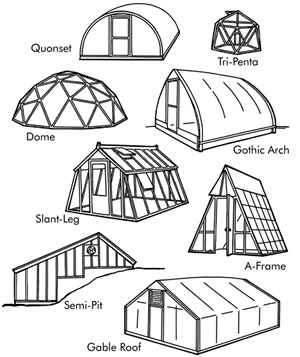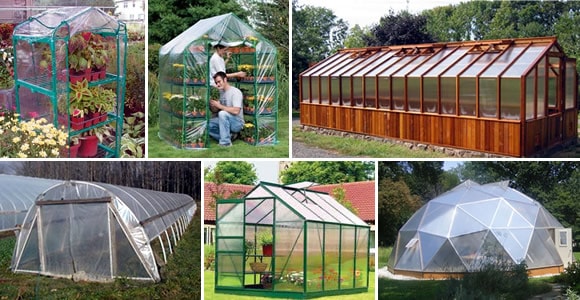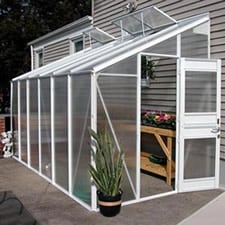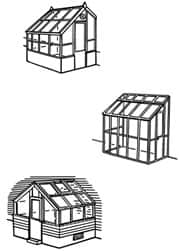One of the most important aspects of becoming self-sufficient is the ability to produce your own food. Many people begin small garden spaces in the backyard as a way to start out and then slowly expand their growing space and variety of crops. Growing your own food can become addictive. After one begins to grow their own food, many will then start looking at new and different methods of how to extend their season and at ways to include plants that require a longer growing season (building a cold frame is a good start).
The vast majority of our country sits at latitudes not suitable for growing vegetables throughout the year and thus leaving us dependent on imported food items both domestically and internationally. We have all heard about food miles and the typical range for food travel is about 1000 miles. The best solution to extend your number of growing days is to look at season extenders and putting in place a greenhouse. With a greenhouse in place you can start growing your own vegetables all year! In addition to a longer growing season, a greenhouse can assist in increasing the variety of crops you are able to grow. For example, those that live too far north or at too high an elevation to successfully grow summer crops (tomatoes, melons, peppers, etc) can lengthen their season long enough to sustain a harvest.The question now is which type of greenhouse is the best? There is a lot of variation and styles to choose from depending on location, size, cost, durability, and of course, what you want to grow. In this article, we will explore the most popular styles available and hopefully help in selecting the right one for your needs.
Free-Standing
Free standing greenhouses are by far the most widely available and customizable structures you can get on the market today. They come in all shapes, sizes, styles and price ranges. When planning on setting up a freestanding greenhouse one needs to keep in the mind the following considerations:
- The type of growing you will be using the greenhouse for. What type of plants do you want to keep in your greenhouse? Do you want to grow year round or use it for seed starting and extending your season? Will it have a solid foundation or will you want to plant directly into the ground?
- Site location and orientation of the greenhouse to maximize sun exposure. Consider site issues such as drainage, snow drifts, sun exposure during the low light of winter, nearby structures that could shade the sun, heavily treed areas, and severely sloped areas. Space limitations available to set up the greenhouse may also determine ultimate size and location. If possible, freestanding greenhouses should be oriented with their broad side facing directly north-south. This will maximize solar exposure during the short winter days when sun is lower on the horizon. They should also be setup to be level.
- Distance to utilities and water hookups. You may want power and water supplies directly connected and installed in the greenhouse.
- Overall weather conditions. What type of weather conditions will your greenhouse be subjected too? High winds? Blazing sun? Heavy Snow? Weather considerations are important for determining the construction materials and overall durability your greenhouse.
Basic Types of Freestanding Greenhouses
- Portable / Collapsible / Patio
- This is an inexpensive and smaller option for seed starting and smaller container plants that need frost protection. Shelving gives you additional vertical space for growing compared to a cold frame.
- Being lightweight and usually easy to take apart, portable greenhouses can be put in storage when it is too hot or too cold to use effectively. On the other side of this, be mindful of wind and snow that can blow over or collapse the structure of these smaller greenhouses, as they usually have no permanent foundation.
- Portable greenhouses are relatively inexpensive, though the materials won't be as durable as bigger kits and systems. Depending on the particular greenhouse, plan on only getting 2-4 seasons out of them without repair.
- High Tunnels
- High tunnels are large hooped frames covered in plastic. They are probably the best value for the amount of growing space one gets for their dollar. High tunnels give the flexibility of being able to grow in the ground year round as well as vertical growing space.
- Snow loads and high winds in your area must be considered as high tunnels are covered in large sheets of poly plastic and can tear or blow off if not secured properly.
- Drainage is an important consideration with high tunnels. Since these structures usually have plants directly in the ground, it is important to consider the soil when you set up a high tunnel.
- Ventilation and roll-up sides are an important consideration with high tunnels because roof vents are not typically included.
- Metal Frame & Poly-Panel Kits
- Metal and poly-panel kit greenhouses are the most popular and accessible to the backyard gardener. They are widely available through many big box stores and an even larger selection can be found online as well. When ordering online, be aware of potentially high shipping charges.
- These greenhouse kits are easy to assemble and are usually placed on a secure base of pressure treated or plastic lumber. They are usually setup with a gravel and sand foundation, and should be setup on a level foundation.
- Most kits include doors and automatic vent openings.
- Some kits can be later expanded on.
- Highly durable and weather secure. Will usually have a 8-10 year warranty.
- Wood Frame & Poly-Panel or Glass Kits
- Traditional wood greenhouse kits are usually a more expensive option but gives a warmer natural feel to your growing space.
- Wood frames insulate better than metal frames, given that wood is a natural insulator.
- Maintenance considerations with wood include mold, mildew and pest issues. These considerations are minimized by choosing a greenhouse made from cedar or redwood.
- As with metal kits, wood framed greenhouses often include doors, automatic vent openings, and can be later expanded upon. They are usually constructed on wood and gravel foundations, and should also be setup level. They are durable and weather and wind tight, if secured properly.
- Geodesic Grow Dome
- A unique greenhouse design that gives excellent in-ground and vertical growing space.
- The design of geodesic grow domes offers an extremely energy efficient growing space. These round structures capture sunlight extremely efficiently, and do not have to be oriented in a north-south direction as with other greenhouses.
- An excellent option to incorporate aquaponics into your growing space. Water tanks are highly recommended with geo-domes as a heat sink and humidity source.
- Commercially available geodesic grow domes can be relatively expensive compared to other options, though there are some DIY designs available.
Attached / Lean-to
This type of greenhouse attaches to an existing structure, such as a house, typically to the south or southwest wall. The construction of attached greenhouses facilitates the sharing of solar heat with the structure that it is attached to. They are ideal in climates with a lot of sunny, yet cold, winter days. As the sun heats up the greenhouse during the day, the heat is then transferred to the house. One can reduce their home's heating cost by up to 70% with a properly designed attached-greenhouse. Attached greenhouses can provide an easier setup of utilities since they are connected to an existing structure.
One important thing to keep in mind with this style of greenhouse is the importance of providing adequate ventilation and shading during the summer months. Shade cloth and vent openings will help keep temperatures from getting too high with this shared growing space.When it comes to winter growing, an attached-greenhouse is hard to beat. The sharing of the south wall with ones home, enables an easy transfer of heat to the greenhouse in cold nights. Who wouldn't want to walk out their door, barefoot in January, and harvest a fresh spinach salad for dinner?
Things to Keep in Mind
- When deciding on which type and size of greenhouse you want it is best to always go bigger than you think you need. Some greenhouses offer expansion capabilities.
- Air circulation and ventilation are key to a properly functioning greenhouse. The plants take up available carbon dioxide relatively quickly and without fresh air moving through the greenhouse the plants will not grow to their full potential. Fans & automatic vent openers may be part of your overall plan and infrastructure.
- Cooling your greenhouse in the summer might be necessary in some climates. For high tunnels, rolling up side walls is normally sufficient. However, in other greenhouse designs (freestanding kits, attached/lean-tos, domes) shade cloth might be necessary. Shade cloth is a simple woven fabric available from any greenhouse supplier. Fans also offer an excellent way to provide ventilation and cooling.
- Depending on your location, heating your greenhouse is normally not necessary unless you want to push the limits on what your growing. When heating does become necessary, options such as small space heaters, kerosene lanterns, and commercially available greenhouse heaters can be invaluable. Heaters can also be connected to water-proof greenhouse thermostats.
- Water has a very high thermal mass value and can store thermal heat that is gained during the day. Adding 55-gallon drums filled with water helps to buffer against the night time temperature lows. Consider using 2 water barrels with wood planking on top. This not only provides an excellent thermal mass but will also save on buying that additional greenhouse bench. Also - the water thermal mass can be used as backup emergency water.
Resources:
Greenhouse Kits:
Growers Supply (FarmTekk): http://www.growerssupply.com/farm/supplies/home
Growing Spaces: http://www.geodesic-greenhouse-kits.com/
Books:
Greenhouse Gardener's Companion, Revised: Growing Food & Flowers in Your Greenhouse or Sunspace
All About Greenhouses (Ortho's All about)
Four-Season Harvest: Organic Vegetables from Your Home Garden All Year Long
This is a companion discussion topic for the original entry at https://peakprosperity.com/selecting-a-greenhouse-2/












